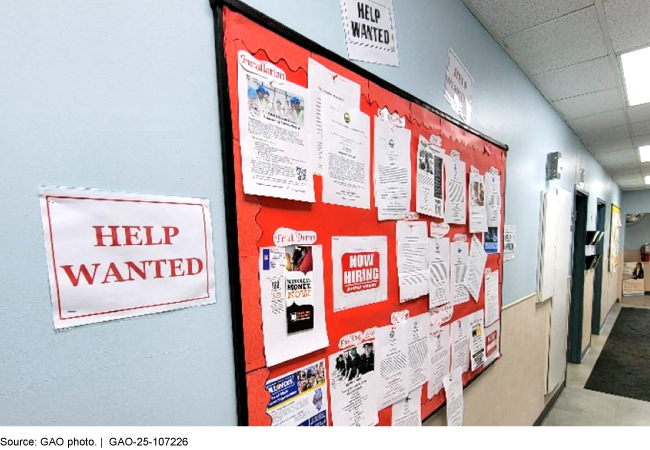Temporary Assistance for Needy Families: Actions Needed to Improve HHS Oversight
Fast Facts
The Temporary Assistance for Needy Families block grant provides money and services such as job training to people in financial need.
We testified about recommendations from our prior reports to improve how the Department of Health and Human Services oversees TANF. For example, HHS could:
Find ways to improve states' reporting on TANF expenditures
Find ways to help states resolve problems found in TANF audits
Better manage the risk of TANF fraud
Fully addressing our prior recommendations would improve HHS's oversight and decision-making on TANF.
A TANF-Supported Facility Showcases Employment Opportunities

Highlights
What GAO Found
Administered by the Department of Health and Human Services (HHS), the Temporary Assistance for Needy Families (TANF) block grant annually provides $16.5 billion to states. Nationwide, state spending on TANF “non-assistance” services—such as job training and child welfare services—increased as a percentage of total TANF spending from fiscal year 2015 through fiscal year 2022 (from 40.8 to 44.2 percent). During that period, “assistance” spending, including cash payments to needy families, decreased as a percentage of total spending (from 27.2 to 25.2 percent).
GAO recently identified various ways that HHS could improve TANF oversight.
- Requiring states to report additional data on TANF expenditures could strengthen HHS's oversight of funds, potentially including oversight of improper payments. In December 2024, GAO found that states' reporting of TANF expenditures did not include detailed information on certain key aspects, such as information on planned non-assistance spending. In April 2022, GAO also recommended that Congress consider providing HHS authority to require states to report data to enable HHS to estimate and report on improper payments for TANF.
- Requiring states to report more data on TANF expenditures could also help to better reflect the amount of federal funds spent on child welfare. In April 2025, GAO found that, nationwide, states spent about $23.5 billion in TANF funds for child welfare purposes from fiscal year 2015 through fiscal year 2022. The amount of TANF funds states spent on child welfare is likely higher than HHS data show, according to selected states.
- Facilitating information sharing among states could help states improve outcome tracking and oversight. In February 2025, GAO reported that, while HHS does not have authority to collect data on those served with TANF non-assistance funds, officials from selected states generally said that they collected and used a variety of such data. Selected state officials said they would like to improve their use of these data.
- Tracking and measuring the resolution of single audit actions could help identify and resolve repeat issues. States and other entities that spend above a certain amount in federal awards (e.g., TANF award funds) in each year are required to undergo an audit of their financial statements and federal awards, known as a “single audit.” In April 2025, GAO identified 37 states with a total of 162 TANF audit findings, including persistent and severe findings in their single audit reports. Additionally, some of these findings involved deficiencies that could lead to improper payments. Moreover, 37 of the findings repeated for 2 or more years, and some remained unresolved for over a decade.
- Fully assessing fraud risks consistent with leading practices would better position HHS to effectively and efficiently manage them. In January 2025, GAO found that HHS's processes for assessing fraud risks were not fully consistent with leading practices, including assessing or determining key aspects of fraud risks.
Why GAO Did This Study
The federal TANF block grant provides support to millions of low-income individuals and families. States are also required to contribute toward TANF spending and collectively spend approximately $15 billion of their own funds each year. States have increasingly shifted spending from assistance to non-assistance services. HHS oversees TANF, including by collecting state expenditure data, monitoring resolution of states' TANF single audit findings, and assessing the risk of TANF fraud.
This statement summarizes GAO's key findings from recent work related to (1) states' reporting on TANF expenditures; (2) states' use of TANF to provide child welfare services; (3) states' use of data on job training and other services funded by TANF; (4) the timeliness of state TANF single audit reports and the extent of unresolved TANF single audit findings; and (5) TANF fraud risk management.
This statement is primarily based on five GAO reports issued between December 2024 and April 2025 (GAO-25-107235, GAO-25-107290, GAO-25-107226, GAO-25-107291, and GAO-107467). Detailed information on the objectives, scope, and methodology can be found within each report. HHS provided technical comments, which we incorporated, as appropriate.
Recommendations
GAO made 13 recommendations to HHS and one to Congress to improve TANF oversight. As of April 2025, the recommendations are open. Fully addressing the recommendations would enhance HHS's oversight efforts and future decision-making on TANF.
